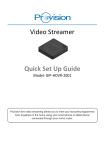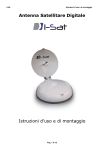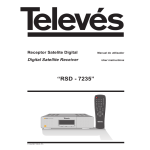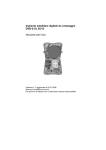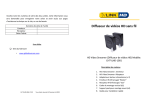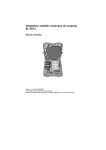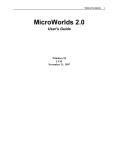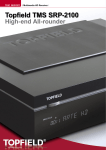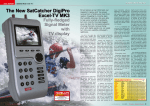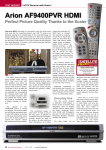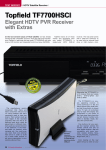Download Global Invacom OptiScan
Transcript
TEST REPORT Optical Meter Global Invacom OptiScan The First Signal Analyzer with an Optical Input TELE-satellite has already reported many times on the British company Global Invacom. It started many years ago with a report on a 0.3 dB LNB and most recently with a report on their newest product - an optical LNB; see TELE-satellite issue 04-05/2008 and 08-09/2009. It’s easy to see that Global Invacom takes a leading roll that others need to follow when it comes to innovative products. And to show that this is true, the engineers recently added one more thing: similar to the optical LNB, the first satellite signal analyzer with an optical signal input is making its appearance in the market. As we unpacked the unit, everyone in the test laboratory was impressed with the overall appearance of the OptiScan; not too heavy, not too light. It sits perfectly in your hand and thus helps to prevent you from accidentally dropping it. But even if that does happen, the manufacturer incorporated the OptiScan in a very sturdy plastic housing. On the upper side there are two signal inputs, one of them is the optical input while the other is in the form of a BNC connector for typical coax cable signals. without background lighting whereas as holding the ON button down longer will start it with background lighting. The signal analyzer is operated using the nine clearly labeled buttons underneath the display; it’s easy to feel when the button has been properly pushed plus they are large enough to make the analyzer easy to use. On the side is the connection for the included 12V power supply which The eight-digit LCD display is easily readable even in direct sunlight. The display’s background lighting is perfectly suited for use in an attic or other location with poor lighting. The background lighting can be turned on or off depending on how the unit itself is powered up. A short push of the ON button starts the OptiScan 44 TELE-satellite — Global Digital TV Magazine — 12-01/2010 — www.TELE-satellite.com 12-01/2010 GLOBAL INVACOM OPTISCAN Future-proof satellite signal analyzer for optical and coaxial LNBs Satellite scan of ASTRA 19.2° east - one signal was found charges the internal rechargeable battery. Accessories include a practical carrying case with carrying strap, the 12V power supply, a car charger, a detailed user manual and a BNC to F adapter. Everyday Use the OptiScan can be used for According to the manufac- up to five hours even when turer, the internal battery of the OptiScan needs roughly 12 hours to fully charge; protective circuitry prevents a standard LNB needs to be supplied with power. But since our test analyzer was already fully charged, we were able to get right to work. the battery from being overcharged. Once fully charged, The OptiScan operates with a real-time spectrum dis- play that covers 950 - 2150 MHz (zoomable to 160 MHz) and works with signal levels between 40 and 90 dBµV (coaxial) as well as +10 to -25 19.2° east, EUTELSAT W2 16° east, HOTBIRD 13° east, EUROBIRD9 9° east, EUTELSATW3A 7° east, SIRIUS 5° east, THOR 1° west, ATLANTIC BIRD3 5° west as well as NILESAT 7°, ATLANTIC BIRD2 8° west, ATLANTIC BIRD1 12.5° west, TELSTAR12 15° west and HISPASAT 30° west. Thanks to this large assortment of satellites, there should be no problems setting up any antenna in Europe. dBm (optical). The following values can be set up individually for each desired transponder: MER (Modulation Error Rate), BER (Bit Error Rate) as well as signal levels in dBµV for coaxial signals and dBm for optical signals. The OptiScan operates via a very practical Favorites function which can be used to store one or more reference transponders for each desired satellite that ultimately makes it easy to access them at a For other continents, the m a n u f a c t u r e r/ d i s t r i b u t o r can naturally set up the list based on local requirements and preprogram the analyzer accordingly. Installation For our tests we loosened the mount on one of our antennas so that we could align it with HISPASAT 30° west. After holding down the ON button for a moment, the OptiScan came to life and immediately displayed the list of Favorites. later time. As many as 99 of these socalled Favorites can be set up in the signal analyzer; 24 of these have already been set up by Global Invacom with transponders from the following European satellites: ASTRA2 28.2° EXPRESS AM22 TURKSAT 42° 53° east, east, east, HELL- ASSAT 39° east, EUROBIRD3 33° east, BADR 26° east, ASTRA3 23.5° east, ASTRA1 46 TELE-satellite — Global Digital TV Magazine — 12-01/2010 — www.TELE-satellite.com We first accessed the main menu so that we could take care of all the settings. The Main Menu is divided into six submenus. To start with you can select whether the OptiScan should work with coaxial or optical signals based on which input is in use. The second submenu contains the stored Favorites while the third submenu serves to store new transponders as Favorites entries. Spectrum display in vertical low band with highest zoom level Favorite Selection Setup Menu Storing a new Favorite Spectrum display without zoom Selecting the LNB power and the desired band Satellite scan of ASTRA 19.2° east - one signal was found DiSEqC Menu Main Menu Storing DiSEqC 1.2 Limits www.TELE-satellite.com — 12-01/2010 — TELE-satellite — Global Digital TV Magazine 47 Submenus 4 and 5 contain multiple LNB power settings, frequency band settings as well as DiSEqC settings. The OptiScan can provide LNBs with 13V and 18V as well as a 22 kHz signal to switch between low band and high band. DiSEqC is naturally also supported including version 1.0 and also 1.2 form control of a DiSEqC motor. In this mode the antenna can not only be moved around during a measurement, but it is also possible to store limits and positions directly in the motor. For more experienced users, there’s also the ability to manually enter DiSEqC commands but this requires some specialized knowledge and above all experience with DiSEqC’s technical specifications. These can be found, for example, at www. eutelsat.com. The sixth submenu “Setup Menu” allows you to reset all the Favorites back to factory settings and also lets you determine how the audio signal level tone can be activated or deactivated. he user can also select whether the BER (bit error rate) should be displayed by Viterbi before or after a correction. If the Viterbi display is selected, the OptiScan measures the error rate as it is transmitted from the satellite. The measurement of the BER gives you a reliable indication of the quality and alignment of the antenna. If you display the BER after the Viterbi correction, the signal has undergone a mathematical correction and does not contain as many errors as before. For our tests we chose entry 13 in the Favorites menu in which transponder 11554 V is stored. After pressing the enter button, the OptiScan switches to its graphical signal display where the spectrum is shown in the range between 11473 and 11635 MHz. Next we moved the antenna around until a signal peak became visible on the display at the preprogrammed frequency. With the help of the two Gain buttons, the scale of the display could be changed. If the signal is very strong and the peak is no longer visible on the display, the scale can be raised so that the test transponder can be more easily seen. Ideally, the signal peak should take up roughly 2/3 of the display. Signal lock of HISPASAT 30° West Spectrum display HISPASAT 30° West With the help of the Up and Down buttons, seven different Zoom levels can be utilized so that the entire spectrum can be viewed or only a small portion just around the transponder. Last but not least the left/ right buttons can be used to modify the entered frequency. This lets you adjust the preprogrammed frequency directly on its center or you can choose a completely different frequency. If the analyzer shows a peak on the dotted line, a simple push of the Enter button puts the OptiScan in measurement mode in which it begins reading in the selected transponders. With the help of the NIT data (if available), the actual satellite, its position and bouquet are confirmed. The user can thus immediately see which satellite is currently aligned to. 48 TELE-satellite — Global Digital TV Magazine — 12-01/2010 — www.TELE-satellite.com At this point the measurement of MER and BER takes place; the graphical and numerical display of the signal level also begins here. If the analyzer recognizes a transponder, „LOCK“ is displayed in the upper edge of This problem became evident during our tests of the optical LNBs from Global Invacom in the 08-09/2009 TELEsatellite issue. Invacom found the perfect solution in the OptiScan thanks to which even optical LNBs can be properly adjusted. the display while „PASS“ indicates that there are acceptable levels of MER and BER and that the transponder was recognized. If „MARGINAL“ or „FAIL“ is displayed, it indicates that the antenna is not correctly aligned and that reception is not possible. There‘s one small issue: In order to keep the price of OptiScan reasonable, Global Invacom decided to restrict the analyzer to show only the vertical low band in the spectrum. Adding the other bands would have made the OptiScan too expensive. This is where the installer begins the fine tuning of the antenna in order to obtain optimal levels. Once the maximum has been reached, the screws on the antenna should be tightened. Thanks to the complete spectrum analyzer display it is easily possible to discover defective cable using the OptiScan since all transponders in several frequency ranges and levels are displayed. If a satellite has been preprogrammed list, it is recthat It is extremely lightweight, sits perfectly in your hand and operates with a high-capacity rechargeable battery that can last up to five hours without any external power source. Conclusion sighted that is not yet in the ommended All in all, the OptiScan analyzer comes with all the necessary features and for the installer it is a future-proof alternative to his previous equipment. this entry be stored as a new Favorites entry so that it is available TECHNICAL DATA Manufacturer Tel +44 (0) 1621 743 440 Fax +44 (0) 1621 743 676 Email [email protected] Model OptiScan Frequency range 950(160)~2150 MHz Range RF input level: 40 dBuV to 90 dBuV Optical range: +10 to -25 dBm Accuracy Typically +/- 1 dB Measuring MER and BER DiSEqC 1.0 and 1.2 compatible plus any DiSEqC command can be generated Uptime Up to 5 hours Charge time Up to 12 hours Items included Carry case, BNC/F adaptor, mains charger, car charger, manual Dimensions 210x110x70mm Weight 0.70kg www.TELE-satellite.com/... TELE-satellite World Download this report in other languages from the Internet: Arabic Indonesian Bulgarian Czech German English Spanish Farsi French Hebrew Greek Croatian Italian Hungarian Mandarin Dutch Polish Portuguese Romanian Russian Swedish Turkish Global Invacom, with its new OptiScan has shown once again that this company is always a step ahead of the competition in the development of new products. with the next scan. We thoroughly tested the OptiScan using both optical and coaxial signal inputs. We were especially thrilled that in the future it is no longer necessary to bring along an optical-to-coaxial signal converter to the installation site. + It remains to be seen what the future holds but one thing is clear: optical signal transmission will sooner or later become more standard and Global Invacom with its optical LNBs and OptiScan analyzer are providing the necessary prerequisites. Expert Opinion Unit sits perfectly in your hand, it is shockresistant and operates with a long-life. It is futureproof for coaxial LNBs as well as for the new optical LNBs - only one satellite polarization is displayed with optical reception Global Invacom, Winterdale Manor, Southminster Road, Althorne, Essex CM3 6BX, ENGLAND Thomas Haring TELE-satellite Test Center Austria 50 TELE-satellite — Global Digital TV Magazine — 12-01/2010 — www.TELE-satellite.com ﺍﻟﻌﺮﺑﻴﺔ Indonesia Български Česky Deutsch English Español ﻓﺎﺭﺳﻲ Français עברית Ελληνικά Hrvatski Italiano Magyar 中文 Nederlands Polski Português Românesc Русский Svenska Türkçe www.TELE-satellite.com/TELE-satellite-1001/ara/optiscan.pdf www.TELE-satellite.com/TELE-satellite-1001/bid/optiscan.pdf www.TELE-satellite.com/TELE-satellite-1001/bul/optiscan.pdf www.TELE-satellite.com/TELE-satellite-1001/ces/optiscan.pdf www.TELE-satellite.com/TELE-satellite-1001/deu/optiscan.pdf www.TELE-satellite.com/TELE-satellite-1001/eng/optiscan.pdf www.TELE-satellite.com/TELE-satellite-1001/esp/optiscan.pdf www.TELE-satellite.com/TELE-satellite-1001/far/optiscan.pdf www.TELE-satellite.com/TELE-satellite-1001/fra/optiscan.pdf www.TELE-satellite.com/TELE-satellite-1001/heb/optiscan.pdf www.TELE-satellite.com/TELE-satellite-1001/hel/optiscan.pdf www.TELE-satellite.com/TELE-satellite-1001/hrv/optiscan.pdf www.TELE-satellite.com/TELE-satellite-1001/ita/optiscan.pdf www.TELE-satellite.com/TELE-satellite-1001/mag/optiscan.pdf www.TELE-satellite.com/TELE-satellite-1001/man/optiscan.pdf www.TELE-satellite.com/TELE-satellite-1001/ned/optiscan.pdf www.TELE-satellite.com/TELE-satellite-1001/pol/optiscan.pdf www.TELE-satellite.com/TELE-satellite-1001/por/optiscan.pdf www.TELE-satellite.com/TELE-satellite-1001/rom/optiscan.pdf www.TELE-satellite.com/TELE-satellite-1001/rus/optiscan.pdf www.TELE-satellite.com/TELE-satellite-1001/sve/optiscan.pdf www.TELE-satellite.com/TELE-satellite-1001/tur/optiscan.pdf Available online starting from 27 November 2009







